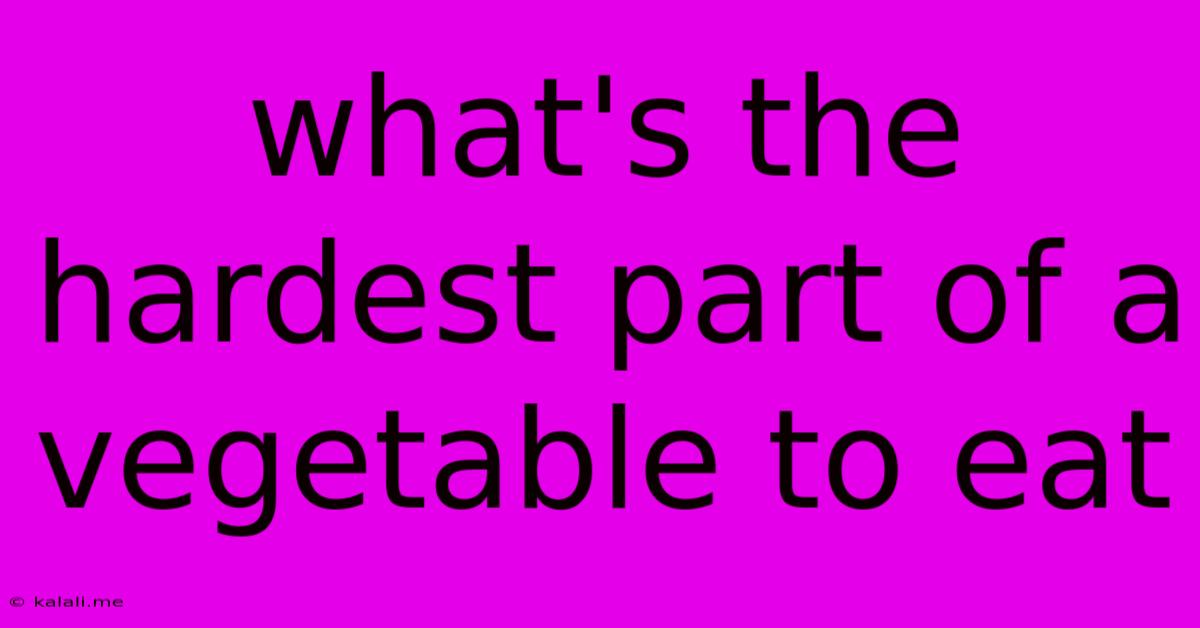What's The Hardest Part Of A Vegetable To Eat
Kalali
May 30, 2025 · 3 min read

Table of Contents
What's the Hardest Part of a Vegetable to Eat? A Surprisingly Delicious Debate
What's the hardest part of a vegetable to eat? It's a question that sparks debate around dinner tables and among culinary enthusiasts alike. While some vegetables present challenges due to their tough skins or fibrous cores, the "hardest" part is often subjective and depends on individual preferences and cooking methods. This article dives into the contenders, explores the reasons behind their difficulty, and offers tips for making even the trickiest vegetable parts palatable.
The contenders for "hardest to eat" often include:
- Broccoli stems: Many discard the thicker stems of broccoli, assuming them to be too tough. However, properly prepared, they are a delicious and nutritious addition to any meal.
- Brussels sprout stems: Similar to broccoli stems, the tough stems of Brussels sprouts are often overlooked, but these too can be softened with proper cooking techniques.
- Celery leaves: While the stalks are a crunchy and refreshing addition to salads and other dishes, the leaves are often deemed too bitter or tough.
- Carrot tops: Most people only use the root, yet carrot greens are highly nutritious and edible, albeit with a slightly bitter taste.
- Asparagus ends: The woody ends of asparagus spears can be quite tough and fibrous, making them unpleasant to eat.
- Cauliflower stems: Much like broccoli, the thick, sometimes tough stem of the cauliflower is often ignored.
Why are these parts so challenging?
The difficulty in eating certain vegetable parts often stems from their:
- Fiber content: High fiber content contributes to toughness. This is particularly true in the stems of broccoli, Brussels sprouts, and cauliflower.
- Toughness of the skin/outer layer: Some vegetables, like certain types of squash or root vegetables, have tough outer layers that require extra effort to peel or cook.
- Bitterness: The leaves of celery and carrot tops often contain higher concentrations of bitter compounds that some find unpalatable.
- Woody texture: Asparagus ends and some vegetable stems develop a woody texture as they mature, making them tough and difficult to chew.
Tips and Tricks for Conquering the "Hardest" Parts
Don't let tough vegetable parts go to waste! Here are some tips for making them more palatable:
- Peel and Trim: Remove the outer layer of tough skin or trim the woody ends of vegetables like asparagus.
- Proper Cooking Methods: Steaming, roasting, or sautéing can soften tough stems and leaves.
- Use in Smoothies: Blend tough vegetable parts into smoothies to hide their texture and add nutrients.
- Add Flavor: Marinades, sauces, or spices can mask bitterness and enhance flavor.
- Finely Chop or Grate: Reduce the size of tough parts to make them easier to eat.
Beyond the Stem: Exploring the Often-Wasted Parts
We often overlook the incredible nutritional value packed into the parts of vegetables we typically discard. By learning to prepare and utilize these often-wasted sections, we reduce food waste and maximize our intake of vitamins, minerals, and fiber. Experimenting with different cooking methods and flavor combinations can unlock new culinary possibilities and introduce surprising deliciousness to your meals.
Ultimately, the "hardest part of a vegetable to eat" remains a matter of personal preference and culinary skill. But with a little know-how and creativity, even the most challenging parts can become a delicious and nutritious addition to your diet.
Latest Posts
Latest Posts
-
Electric Motor Wiring Diagram 3 Phase
Jun 01, 2025
-
Carbon Monoxide Poisoning From Gas Stove
Jun 01, 2025
-
All And All Or All In All
Jun 01, 2025
-
Signs You Need A New Car Battery
Jun 01, 2025
-
Are Christians Supposed To Eat Pork
Jun 01, 2025
Related Post
Thank you for visiting our website which covers about What's The Hardest Part Of A Vegetable To Eat . We hope the information provided has been useful to you. Feel free to contact us if you have any questions or need further assistance. See you next time and don't miss to bookmark.